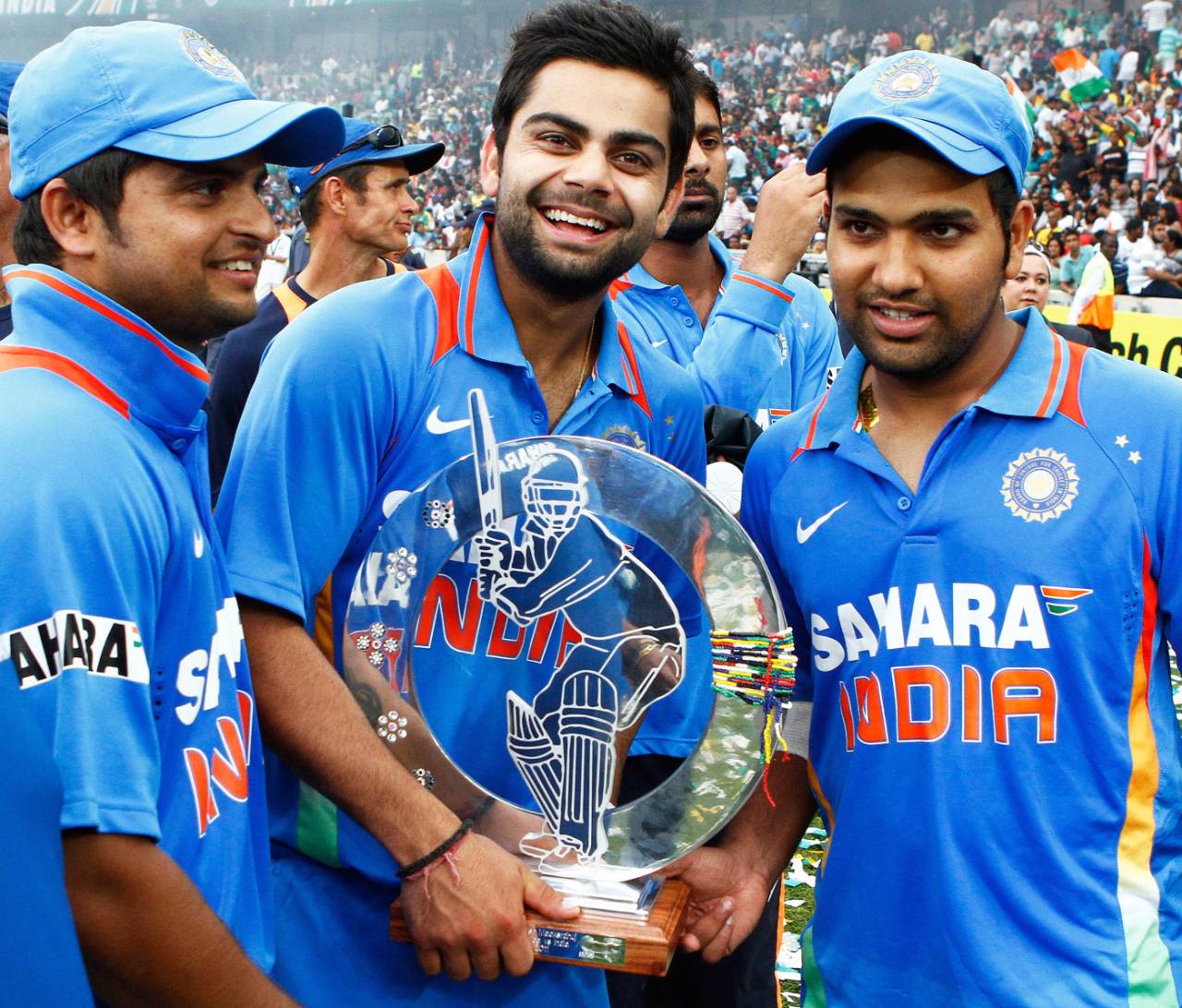India's T20 line-up problem
It is one of their great strengths to be able to take the same foundation into every format, but in the shortest, it just might also be a weakness
Sidharth Monga
07-Oct-2015

Raina, Kohli and Rohit play similar roles in the batting orders of their respective IPL franchises, which is a disadvantage when all are playing T20s for India • AFP
In Rohit Sharma, Virat Kohli and Suresh Raina, India have arguably three of the best T20 batsmen going around today, yet the team has many a problem. And MS Dhoni's lack of form is not the biggest of those problems. India simply don't have batsmen who dovetail to form a good T20 side. Or at least such is their reputation going by the way the XI is being selected.
Rohit, Kohli and Raina play for different franchises in IPL cricket. That is something they hardly do in longer formats, given they play very little domestic cricket. Which means almost all the 50-over and first-class cricket India's best batsmen play, they play alongside each other, as a team. It just so happens the best batsmen of this Indian T20 international team are used to playing the same or similar roles for their own franchises, where they all have T20 specialist hitters following them. Trouble is, those specialist lower-middle-order batsmen are mostly foreigners. And India can't play those foreigners.
Except for Raina to an extent, none of these three is a specialist hitter from ball one. They all prefer to face a few balls before they begin bashing. We have Rohit, Shikhar Dhawan and Ajinkya Rahane, whose best station is at the top of the innings. Then we have Kohli and Raina, who are ideally suited to No. 3. There are no Nos. 4, 5 or 6. Dhoni is just coming to terms with the fact that a lot of T20 batting is just a slog from ball one.

Rahane gets short-changed when it comes to his place in the order because of his more adaptable batting•Getty Images
Ambati Rayudu gets picked because Rahane is considered as somebody who can hit either the new ball or the old one on quick pitches. Captain one match, water boy the next. Yet there isn't much between the stats of Rahane and the men he loses out to. Rahane strikes at 118 per 100 balls in T20 cricket. It is only slightly behind Dhawan's 120, who gets preferred presumably because of the need for a left-right combination. Rayudu is considered to be the bigger six-hitter. Yet his T20 strike rate is only 123, and the only three T20 international innings Rayudu has played have been two ducks and one innings where Dhoni farmed the strike.
If India do go ahead and ask Rohit to make the sacrifice of moving down to accommodate Rahane and provide big-hitting ability in the middle order, there is a serious threat of Rahane and Dhawan getting stuck at the top. One solution could be to push Kohli to the top, where he has played in the IPL. It could give Raina his best position in the order, but there is still one spot that goes to either Rayudu or one out of Dhawan and Rahane.
And that's assuming Dhoni's place in the XI goes unquestioned. He has never hit a fifty in T20 internationals, continues to be stubborn in that he wants to bat for only a certain number of deliveries (even if that means rearranging the batting order around him), and has now admitted his thoughtful batting might not be working in this format.

Should Dhoni's place in the side go unquestioned?•AFP
It is a little easier to plan against Indian batsmen than against others. There is no jack-in-the-box here, playing not to the merit of the ball, opening up the whole field through reverse sweeps and switch hits. It is one of India's great strengths to be able to take the same foundation into every format; Dhoni doesn't see that as a gaping hole.
"Our team, if you see, most of our batsmen play quite the same in T20 and 50-over format," Dhoni said after India lost the T20 series to South Africa. "That's what their strength is. All of a sudden we can't ask them to play the kind of game that is not their strength. I feel they have been doing well. Consistently we have been giving par scores to the bowlers. At times we have chased scores that are really big. Not to forget the last time Australia played an ODI series in India we had to chase 350 twice. Our strength is playing proper cricketing shot. I feel it is quite good, the way the batsmen have responded. On and off we see this kind of performances."
India hardly play T20 internationals between the World T20s, which is possibly why the reference points tend to be ODIs. Now India have a few matches before the World T20 to figure out if they need to partially move away from their set ways and look at a Deepak Hooda or a Gurkeerat Mann, or have Dhoni bat like, say, Kieron Pollard. Because when the Indian spinners are not effective the "par scores" that the old-fashioned ways have been giving them prove to be not enough.
Sidharth Monga is an assistant editor at ESPNcricinfo